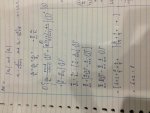I think it is better to see the attached file because the editor doesn't seem to accept my editing.
a1 a2 a3 infinity an 2^n 3^n
-- + -- + -- + .... = sum --- where an= ------ and bn= -------
b1 b2 b3 n=1 bn n*(n+2) 5 *n+18
(note: a1 is a subscript 1 and an is a subscript n and bn is b subscript 1)
The Thai tutor shows his solution where he eventually comes to a point where he simplifies the sum which make things easy to cancel one and another out.
What gave him the idea to go to that point? How would students know to work it out to that point or is there a theorem I'm missing.
Let me try to show his solution:
an 5*n+18 9*(n+2) - 4*n 9 4
--- = ---------- * (2/3)^n = (----------------)*(2/3)^n = (--- - ------)*(2/3)^n
bn n*(n+2) n*(n+2) n n+2
It took me a couple of minutes to figure out what he was doing. But the step above made me wondering why would he want to do this, but all right...
Then eventually he arrives at this point.
infinity 9 4 infinity 9 infinity 4
sum [ ---*(2/3)^n - --- *(2/3)^n] = sum --- *(2/3)^n - sum ----- * (2/3)^n
n=1 n n+2 n=1 n n=1 n+2
And this is exactly my question how did he know beforehand that this will result to cancel things out. What is the background knowledge to make him go to this point?
= [ 6 + 2 + 8/9 + 4/9 + .... ] - [ 8/9 + 4/9 + ....] = 6 + 2 = 8
finally the answer is EIGHT
Once again my question is if there's a kind of theorem to solve this problem.
Are these questions supposed to be for high school students of grade 12?
Anyway, I would appreciate the support and I thank you in advance.

a1 a2 a3 infinity an 2^n 3^n
-- + -- + -- + .... = sum --- where an= ------ and bn= -------
b1 b2 b3 n=1 bn n*(n+2) 5 *n+18
(note: a1 is a subscript 1 and an is a subscript n and bn is b subscript 1)
The Thai tutor shows his solution where he eventually comes to a point where he simplifies the sum which make things easy to cancel one and another out.
What gave him the idea to go to that point? How would students know to work it out to that point or is there a theorem I'm missing.
Let me try to show his solution:
an 5*n+18 9*(n+2) - 4*n 9 4
--- = ---------- * (2/3)^n = (----------------)*(2/3)^n = (--- - ------)*(2/3)^n
bn n*(n+2) n*(n+2) n n+2
It took me a couple of minutes to figure out what he was doing. But the step above made me wondering why would he want to do this, but all right...
Then eventually he arrives at this point.
infinity 9 4 infinity 9 infinity 4
sum [ ---*(2/3)^n - --- *(2/3)^n] = sum --- *(2/3)^n - sum ----- * (2/3)^n
n=1 n n+2 n=1 n n=1 n+2
And this is exactly my question how did he know beforehand that this will result to cancel things out. What is the background knowledge to make him go to this point?
= [ 6 + 2 + 8/9 + 4/9 + .... ] - [ 8/9 + 4/9 + ....] = 6 + 2 = 8
finally the answer is EIGHT
Once again my question is if there's a kind of theorem to solve this problem.
Are these questions supposed to be for high school students of grade 12?
Anyway, I would appreciate the support and I thank you in advance.
Attachments
Last edited:

